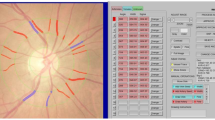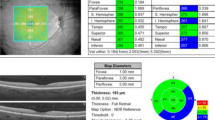Abstract
Purpose
To analyze the differences in terms of choroidal vascularity index (CVI) and choroidal thickness (CT) between the airline pilots–cabin crew and the normal population.
Methods
In this prospective study, 50 airline pilots–cabin crew (study group) and 50 healthy individuals (control group) were included for comparison. For each participant, one eye, the eye with the higher OCT scan score index, was enrolled. Subfoveal CT and CVI were measured using a spectral-domain optical coherence tomography system with enhanced depth imaging.
Results
There were no significant differences in terms of age and sex between the study and control groups. The mean CT was 368.5 ± 79.6 in the control group vs. 424.9 ± 80.7 in the study group (p = 0.001). CT was significantly thicker in the study group. The mean CVI was 64.3 ± 1.5 in the control group and 66 ± 3.1 in the study group (p = 0.5). There was no significant correlation between the study and control groups in terms of CVI.
Conclusion
Airline pilots–cabin crew had thicker CT, but there were no differences in CVI when they were compared with healthy subjects. The effect of unique occupational exposures of airline pilots–cabin crew to the pathophysiology of choroidal structural alterations needs further investigation.

Similar content being viewed by others
References
Wen CCY, Nicholas CL, Clarke-Errey S, Howard ME et al (2020) Health risks and potential predictors of fatigue and sleepiness in airline cabin crew. Int J Environ Res Public 18(1):13. https://doi.org/10.3390/ijerph18010013
Goffeng EM, Nordby KC, Tarvainen M, Järvelin-Pasanen S et al (2019) Cardiac autonomic activity in commercial aircrew during an actual flight duty period. Aerosp Med Hum Perform 90:945–952. https://doi.org/10.3357/amhp.5389.2019
Fischer MD, Schatz A, Seitz IP, Schommer K et al (2015) Reversible increase of central choroidal thickness during high-altitude exposure. Invest Ophthalmol Vis Sci 56:4499–4503. https://doi.org/10.1167/iovs.15-16770
Hirukawa-Nakayama K, Hirakata A, Tomita K, Hiraoka T et al (2014) Increased choroidal thickness in patient with high-altitude retinopathy. Indian J Ophthalmol 62:506–507. https://doi.org/10.4103/0301-4738.116483
Singh SR, Vupparaboina KK, Goud A, Dansingani KK et al (2019) Choroidal imaging biomarkers. Surv Ophthalmol 64:312–333. https://doi.org/10.1016/j.survophthal.2018.11.002
Pichi F, Aggarwal K, Neri P, Salvetti P et al (2018) Choroidal biomarkers. Indian J Ophthalmol 66:1716–1726. https://doi.org/10.4103/ijo.ijo_893_18
Olver JM (1990) Functional anatomy of the choroidal circulation: methyl methacrylate casting of human choroid. Eye 4:262–272. https://doi.org/10.1038/eye.1990.38
Bhayana AA, Kumar V, Tayade A, Chandra M et al (2019) Choroidal thickness in normal Indian eyes using swept-source optical coherence tomography. Indian J Ophthalmol 67:252–255. https://doi.org/10.4103/ijo.ijo_668_18
Wei X, Sonoda S, Mishra C, Khandelwal N et al (2018) Comparison of choroidal vascularity markers on optical coherence tomography using two-image binarization techniques. Invest Ophthalmol Vis Sci 59:1206–1211. https://doi.org/10.1167/iovs.17-22720
Laviers H, Zambarakji H (2014) Enhanced depth imaging-OCT of the choroid: a review of the current literature. Graefes Arch Clin Exp Ophthalmol 252:1871–1883. https://doi.org/10.1007/s00417-014-2840-y
Agrawal R, Ding J, Sen P, Rousselot A et al (2020) Exploring choroidal angioarchitecture in health and disease using choroidal vascularity index. Prog Retin Eye Res 77:100829. https://doi.org/10.1016/j.preteyeres.2020.100829
Iovino C, Pellegrini M, Bernabei F, Borrelli E et al (2020) Choroidal vascularity index: an in-depth analysis of this novel optical coherence tomography parameter. J Clin Med 9:595. https://doi.org/10.3390/jcm9020595
Agrawal R, Gupta P, Tan KA, Cheung CM et al (2016) Choroidal vascularity index as a measure of vascular status of the choroid: measurements in healthy eyes from a population-based study. Sci Rep 6:21090. https://doi.org/10.1038/srep21090
Hu X, Lodewijks G (2020) Detecting fatigue in car drivers and aircraft pilots by using non-invasive measures: the value of differentiation of sleepiness and mental fatigue. J Safety Res 72:173–187. https://doi.org/10.1016/j.jsr.2019.12.015
Aljurf TM, Olaish AH, BaHammam AS (2018) Assessment of sleepiness, fatigue, and depression among Gulf cooperation council commercial airline pilots. Sleep Breath 22:411–419. https://doi.org/10.1007/s11325-017-1565-7
Nkrumah G, Paez-Escamilla M, Singh SR, Rasheed MA et al (2020) Biomarkers for central serous chorioretinopathy. Ther Adv Ophthalmol 12:2515841420950846. https://doi.org/10.1177/2515841420950846
Petrassi FA, Hodkinson PD, Walters PL, Gaydos SJ (2012) Hypoxic hypoxia at moderate altitudes: review of the state of the science. Aviat Space Environ Med 83:975–984. https://doi.org/10.3357/asem.3315.2012
Bouak F, Vartanian O, Hofer K, Cheung B (2018) Acute mild hypoxic hypoxia effects on cognitive and simulated aircraft pilot performance. Aerosp Med Hum Perform 89:526–535. https://doi.org/10.3357/amhp.5022.2018
Hayreh SS, Zimmerman MB, Podhajsky P, Alward WL (1994) Nocturnal arterial hypotension and its role in optic nerve head and ocular ischemic disorders. Am J Ophthalmol 117:603–624. https://doi.org/10.1016/s0002-9394(14)70067-4
Ozdemir I, Kocamis SI, Ersoz MG (2022) Comparison of the long-term effects of high and low altitude on the choroidal thickness. Med Sci 11:335–337
Yang Y, Yang D, Sun Y, Xie Y et al (2019) Retinal vessel oxygen saturation and vessel diameter in healthy individuals during high-altitude exposure. Acta Ophthalmol 97:279–286. https://doi.org/10.1111/aos.13897
Willmann G, Fischer MD, Schatz A, Schommer K et al (2013) Retinal vessel leakage at high altitude. JAMA 309:2210–2212. https://doi.org/10.1001/jama.2013.5550
Jonas JB, Wang N, Wang YX, You QS et al (2014) Subfoveal choroidal thickness and cerebrospinal fluid pressure: the Beijing eye study 2011. Invest Ophthalmol Vis Sci 55:1292–1298. https://doi.org/10.1167/iovs.13-13351
Imray C, Wright A, Subudhi A, Roach R (2010) Acute mountain sickness: pathophysiology, prevention, and treatment. Prog Cardiovasc Dis 52:467–484. https://doi.org/10.1016/j.pcad.2010.02.003
Ersoz MG, Kesim C, Karslioglu MZ, Yildiz-Tas A et al (2021) Repeatability of choroidal vascularity index measurements using directional optical coherence tomography images. Retina 41:1723–1729. https://doi.org/10.1097/iae.0000000000003086
Acknowledgements
The study was performed in Biruni University Hospital, Istanbul, Turkey. The authors had full access to all the data in the study and take full responsibility for the integrity and the accuracy of the data as well as the decision to submit for publication. All authors approved the manuscript and its submission. The manuscript has not been presented in any congress or evaluated in any form by another journal.
Funding
This research received no specific grant from any funding agency in the public, commercial, or not-for-profit sectors. No payment or services have been received from a third party for any aspect of the submitted work, including design, data collection, analysis, or interpretation of the data, writing of the report, or in the decision to submit the article for publication.
Author information
Authors and Affiliations
Contributions
BI is the first author of this article. Designed the study: BI, MGE. Preparation of ethics forms and apply: BI. Manuscript preparation, analysis interpretation of data: BI, MGE, MSO. Contributed reagents/materials/analysis tools: BI. Wrote the paper: BI, MGE. Collected and entered the data: BI, MGE, MSO. All authors read and approved the final manuscript.
Corresponding author
Ethics declarations
Competing interests
The authors declare no competing interests.
Additional information
Publisher's Note
Springer Nature remains neutral with regard to jurisdictional claims in published maps and institutional affiliations.
Rights and permissions
Springer Nature or its licensor (e.g. a society or other partner) holds exclusive rights to this article under a publishing agreement with the author(s) or other rightsholder(s); author self-archiving of the accepted manuscript version of this article is solely governed by the terms of such publishing agreement and applicable law.
About this article
Cite this article
Isık, B., Ersoz, M.G. & Ofluoglu, M.S. Choroidal structural changes in airline pilots and cabin crew. Int Ophthalmol 43, 1819–1823 (2023). https://doi.org/10.1007/s10792-022-02580-3
Received:
Accepted:
Published:
Issue Date:
DOI: https://doi.org/10.1007/s10792-022-02580-3




